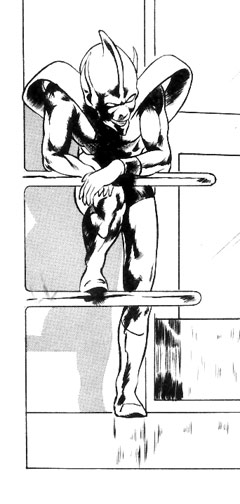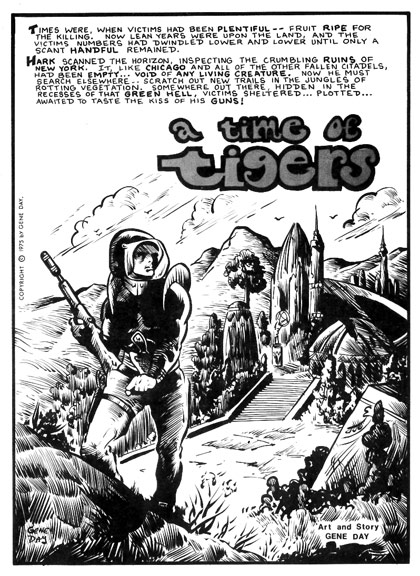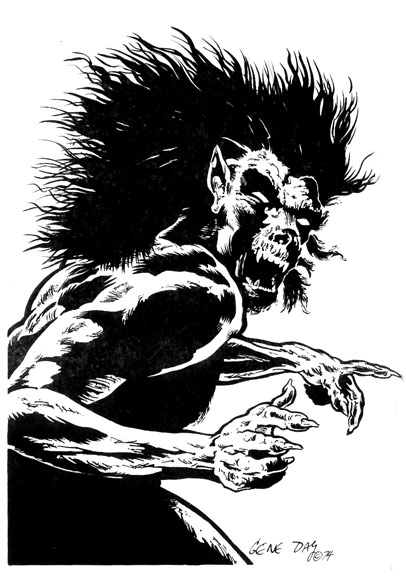Gene Day worked in professional comics for a spell, including a great run on Marvel’s Master of Kung–Fu. But, before his big break came, he contributed to many fanzines, including today’s installment, Epitaph!
Epitaph 1: 1975
Publisher and Editor: Larry Nibert
There were a multitude of fanzines assembled and participated in by artists trying to make it to “the big time.” Larry Nibert, an artist and writer, was one of these hopefuls and his vessel was called Epitaph.
Maybe you shouldn’t judge a book by its cover, but in this case, it could be true that I purchased this particular fanzine because of the slick cover by Mitch Sonoda. Sonoda had been in a few other fanzines in my possession (one that comes to mind was called simply, Fanzine ’77). He was a very polished inker with a style reminiscent of Neal Adams, as seen in the figure below left. In fact, I wouldn’t be surprised if Sonoda cleverly used an Adams figure to build this character with, as it is a very Adams like stance.
 Sonoda was especially good at science fiction, and his strip in this issue, Doomsdawn, falls squarely in that genre. The only disappointment is that we only get a small indication of the cool spaceships Sonoda could seemingly pump out at will. There is liberal use of zip-a-tone throughout his story, and an EC inspired twist ending. Sonoda also inks a Larry Nibert full-page illustration (see above right) that looks as if it was a prequel to the following story by Nibert, if you didn’t look more closely. You can see a small snippet from Nibert’s story, Survivors below. This story is sort of a combination of SF and Sword and Sorcery, with yet another twist at the end. It appears the Epitaph boys loved their EC comics!
Sonoda was especially good at science fiction, and his strip in this issue, Doomsdawn, falls squarely in that genre. The only disappointment is that we only get a small indication of the cool spaceships Sonoda could seemingly pump out at will. There is liberal use of zip-a-tone throughout his story, and an EC inspired twist ending. Sonoda also inks a Larry Nibert full-page illustration (see above right) that looks as if it was a prequel to the following story by Nibert, if you didn’t look more closely. You can see a small snippet from Nibert’s story, Survivors below. This story is sort of a combination of SF and Sword and Sorcery, with yet another twist at the end. It appears the Epitaph boys loved their EC comics!
 After Survivors, we are treated to another cautionary tale aptly titled Epitaph, showing a protagonist and the girl of his dreams, who is not all she appears to be. This story is uncredited, but I think the artist is Bill Morse, who contributes a one-page visual exercise of sorts earlier in the zine. Nibert illustrates a poem by James Pack called The Forever Cave. Pack edited several other fanzines, the names of which escape me at this time.
After Survivors, we are treated to another cautionary tale aptly titled Epitaph, showing a protagonist and the girl of his dreams, who is not all she appears to be. This story is uncredited, but I think the artist is Bill Morse, who contributes a one-page visual exercise of sorts earlier in the zine. Nibert illustrates a poem by James Pack called The Forever Cave. Pack edited several other fanzines, the names of which escape me at this time.
The star of the show here, though, is writer/artist Gene Day. Day cut his teeth on many a fanzine and small magazine before going on to do a host of professional comics. Perhaps his most well known was a run on Marvel’s Master of Kung-Fu, where he first started as an inker to Mike Zeck, but then took over all art duties soon after Zeck succumbed to the dreaded deadline doom. Day’s run on MOKF has been highly lauded over the years, and rightly so. The artist was a master of shadows, as you can see from his strip, A Time of Tigers, above and below.
Day was closely linked to Cerebus creator, Dave Sim, early on. Both were Canadian, and one tended to assist the other whenever possible. Sim lettered several of Day’s early strips. Sim remarks fondly on his late friend by saying:
Gene really showed me that success in a creative field is a matter of hard work and productivity and persistence. I had done a handful of strips and illustrations at that point mostly for various fanzines but I wasn’t very productive. I would do a strip or an illustration and send it off to a potential market and then wait to find out if they were going to use it before doing anything else. Or I’d wait for someone to write to me and ask me to draw something. Gene was producing artwork every day and putting it out in the mail and when it came back he’d send it out to someone else. He would draw work for money and then do work on spec if the paying markets dried up. He kept trying at places where he had been rejected. He did strips, cartoons, caricatures, covers, spot illos, anything that he might get paid for. He gave drawing lessons and produced his own fanzines.
It was easy to see the difference, to see why he was a success and I was a failure. It was in the fall of 1975 that I bought a calendar and started filling the squares with whatever it was that I had produced that day and worked to put together months-long streaks where I produced work every day. The net result was that I started to get more paying work and a year later I was able to move out of my parents’ house into my own one-room apartment/studio downtown. I doubt that would ever have happened without Gene’s influence.
Day self published his work, one of which is advertised in this fanzine as Dark Fantasy, with the appropriately named company, House of Shadows. Day is held in such high regard in his home country that there is a self publishing award and grant in his name (that you can read about here). Gene had two brothers, Dan and David, who also illustrated comics and fanzines, of which a few I have in my possession and will profile some time soon. You can find out more about Dan Day here. You can also see his Swamp Thing work here, his Sherlock Holmes work here, and a list of comic work here.
From the Joe Shuster Canadian Comic Book Creator Blog:
Gene Day began his career with Canadian underground and independent comics, for which he published the short-lived title Out of the Depths in 1974, and collaborated with Dave Sim on Oktoberfest Comics #1 (Now and Then Publications, 1976). Day also penciled for Skywald Publication’s horror-comics magazines Psycho and Nightmare, starting in late 1974, as well as the science fiction-oriented Orb.
For Mike Friedrich’s early independent-comics company Star Reach, in 1977 and 1978, Day variously wrote/drew stories for the namesake anthology title Star Reach and its sister magazines Imagine and Quack, the latter a funny animal comic. Other work includes Cheating Time!, written by Mark Burbey, in Dr. Wirtham’s Comix & Stories #4 (1979).
In 1979, Day wrote and drew an early graphic novel, Future Day (Flying Buttress Press), a hardcover collection of seven stories that he called a “graphic album.” Dave Sim was letterer. Day also did illustrations for the fantasy role-playing games Arena of Khazan: A Tunnels & Trolls Solitaire Dungeon (1979) and Call of Cthulhu (1981).
Day began his seven-year association with Master of Kung Fu by inking penciler Mike Zeck starting with issue #76 (May 1976). He began doing finished art over Zeck’s breakdowns starting with issue ##94 (Nov. 1980), and became series penciler from #102-120 (July 1981 – Jan. 1983), after having split the work with Zeck on the double-sized #100. Day inked Carmine Infantino on Marvel’s 1977-1986 Star Wars sequel series, occasionally doing finished art over breakdowns, and pencilling the well-received issue #69 (March 1983), which took place at Boba Fett’s ancestral homeworld of Mandalore. Day also had significant stints inking The Mighty Thor, and Marvel Two-in-One featuring the Thing.
Day died of a coronary in his sleep [in 1982].
A frequent collaborator and writer, David Olbrich has a wonderful blog post on Gene Day here, with a few replies from various Marvel and other company contributors. Another bio can be seen here. There is even a listing of many fanzines and small magazines Gene worked on here. And lastly, you can see a listing of Gene’s professional comic credits here. You can see from these various listings how industrious Gene Day was. I am sure he would have produced a massive amount of work by now, if he were still alive. There were few in the fanzine world that had as good a command of the depiction of shadows and light as did Gene Day. He has been and will continue to be missed.
Lastly, of course, please download the pdf!
ken meyer jr
kenmeyerjr@yahoo.com








Thanks for another great column, Ken. Gene Day was a regular contributor to Gordon Linzner’s Space & Time during the 70s and 80s.
Great stuff Ken! Marvel Two-In One was a great book, especially from a visual standpoint.
Yeah, Richard…I have several Space and Time’s…but they are so text heavy, I have resisted posting them (I have art in a few, even).
Pingback: Ink Stains 125: Fanzine 75, 76, 77 – ComicAttack.net